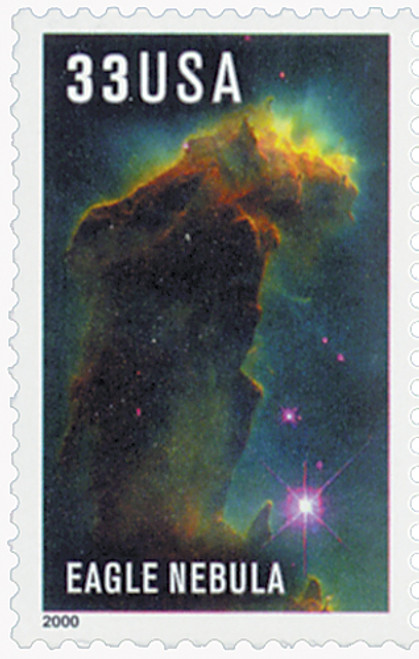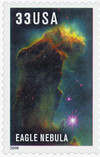
2000 33c Edwin Powell Hubble: Eagle Nebula
# 3384 - 2000 33c Edwin Powell Hubble: Eagle Nebula
$1.10 - $3.20
U.S. #3384
2000 33¢ Eagle Nebula
Edwin Powell Hubble
2000 33¢ Eagle Nebula
Edwin Powell Hubble
Issue Date: April 10, 2000
City: Greenbelt, MD
Quantity: 105,350,000
Printed By: American Packaging Corp. for Sennett Security Products
Printing Method: Photogravure
Perforations: 11
Color: Multicolored
City: Greenbelt, MD
Quantity: 105,350,000
Printed By: American Packaging Corp. for Sennett Security Products
Printing Method: Photogravure
Perforations: 11
Color: Multicolored
Launched April 25, 1990, the Hubble Space Telescope is the most important scientific device used to examine the skies since Galileo’s telescope. The huge instrument can “see” the cosmos clearer than land-based telescopes because of its position above Earth’s distorting atmosphere. Hubble has proven the existence of black holes, captured a comet’s collision with Jupiter, and taken the first images of Pluto and its satellite, Charon.
Hubble is a reflecting telescope constructed like an orbiting observatory. Its main light-gathering mirror measures 94 inches in diameter. NASA controls Hubble from Goddard Space Flight Center in Maryland.
The telescope is named for Edwin Powell Hubble (1889-1953), an American astronomer whose extensive studies of galaxies helped explain the structure, size, and evolution of the universe. He was the first to note that the universe contains star systems other than our Milky Way. Hubble conducted most of his research at Mount Wilson Observatory in California.
The Eagle Nebula lies 7,000 light years away in the constellation Serpens. Visible in the Hubble image are dense clouds of dust and gas that provide a safe place for stars to be born. The newborn stars emit ultraviolet light that illuminates the surfaces of the clouds.
U.S. #3384
2000 33¢ Eagle Nebula
Edwin Powell Hubble
2000 33¢ Eagle Nebula
Edwin Powell Hubble
Issue Date: April 10, 2000
City: Greenbelt, MD
Quantity: 105,350,000
Printed By: American Packaging Corp. for Sennett Security Products
Printing Method: Photogravure
Perforations: 11
Color: Multicolored
City: Greenbelt, MD
Quantity: 105,350,000
Printed By: American Packaging Corp. for Sennett Security Products
Printing Method: Photogravure
Perforations: 11
Color: Multicolored
Launched April 25, 1990, the Hubble Space Telescope is the most important scientific device used to examine the skies since Galileo’s telescope. The huge instrument can “see” the cosmos clearer than land-based telescopes because of its position above Earth’s distorting atmosphere. Hubble has proven the existence of black holes, captured a comet’s collision with Jupiter, and taken the first images of Pluto and its satellite, Charon.
Hubble is a reflecting telescope constructed like an orbiting observatory. Its main light-gathering mirror measures 94 inches in diameter. NASA controls Hubble from Goddard Space Flight Center in Maryland.
The telescope is named for Edwin Powell Hubble (1889-1953), an American astronomer whose extensive studies of galaxies helped explain the structure, size, and evolution of the universe. He was the first to note that the universe contains star systems other than our Milky Way. Hubble conducted most of his research at Mount Wilson Observatory in California.
The Eagle Nebula lies 7,000 light years away in the constellation Serpens. Visible in the Hubble image are dense clouds of dust and gas that provide a safe place for stars to be born. The newborn stars emit ultraviolet light that illuminates the surfaces of the clouds.













